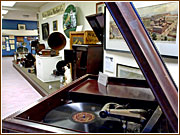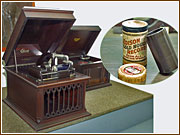AN ANTIQUE EXHIBIT THAT SINGS
Camden Museum Resurrects Era of Hand-Cranked Victrolas
By Hoag Levins
 | |
 March 4, 2002
March 4, 2002
CAMDEN, N.J. -- In the middle of the normally hushed first floor gallery of the Camden County Historical Society Museum, Enrico Caruso suddenly burst into song. A group of visiting senior citizens gathered around the wooden horn of the 94-year-old music player stepped back, obviously surprised by the power of the sound. Previously sedate, the group's members became animated. One clapped her hands in unexpected delight. "Amazing," said another to no one in particular. A third's face stretched into a quiet smile at the operatic beauty of the nostalgic performance.
For the next twenty minutes, as they listened to more songs on hand-cranked players, the visitors repeatedly interrupted the exhibit narrator to tell their own stories about how their grandparents and great aunts used these same machines to fill their living rooms with joy and their family members' heads with memories.
'Strikes a chord'
"Older visitors just light up and come out of themselves when we start playing these things," said museum tour guide Judy Snyder. "It really strikes a chord." Just recently opened, the Society's refurbished audio history display features eight fully-operational spring-powered Edison and Victrola machines from the first quarter of the century.
"When I first walked through this visually lovely collection of historic audio equipment and my first thought was, 'How sad that

|
| The Historical Society's exhibit features the region's largest display of operational Victrolas and Edison music players. Larger photo. | it's silent,'" she said. "It was more like a furniture display than a story of the earliest days of recorded music. You could just feel that this exhibit wanted to sing."
Ms. Snyder and other Society staffers cleaned and repaired the machines, rummaging through the Historical Society's storage areas to locate original replacement parts, needles, records and cylinders.
14 Victor Talking Machines
"We have an incredible trove of material related to the Victor Talking Machine Company and the early history of the recorded music business because Camden was a major center of that industry," she said. "We have nearly 20 machines that date from
1898 to the 1940s and include everything from an early patent prototype for the gramophone to 14 various models of Victor Talking Machines. And we have boxes and boxes of old records we haven't even catalogued yet."
"What makes it really exciting," she continued, "is that none of this involves simulations. These are the original records and cylinders playing on the original machines. This is the real

Photo: Hoag Levins
|
In the foreground, left, is a 1910 Edison table Model 5 wax cylinder-playing phonograph in perfect operational condition. The museum has five wax cylinder recordings in their original containers (right) and is looking for more. Larger photo.
Listen to George M. Cohan (RealAudio) singing "Over There" on this Edison cylinder machine. | thing just as your grandmother and great-grandmother experienced it."
At the far end of the exhibit area, she patted the side of a fancy wooden box whose interior looked more like a machine shop instrument than a record player. Dating to 1910, it is a Thomas Edison wax cylinder player. Edison invented the first audio recording device in 1877, which he called the phonograph. It used a stylus to record sound vibrations as grooves around a cylinder. The cylinder was then reproduced and could be played back on the wind-up home machines that reversed the process.
She gave the 92-year-old machine a crank, slipped on a thick cylinder and flipped several levers. A tinny but vibrant George M. Cohan filled the air with "Over There."
'Yankee Doodle Dandy'
"When I play this for most of the adults, they immediately see James Cagney singing this song in his 'Yankee Doodle Dandy' role," she said, "but this is the real song sung by the artist who wrote it."
Cohan, a turn-of-the-century broadway producer and composer, wrote "Over There" on April 6, 1917 -- the day the U.S. entered the first world war. Wildly popular as a patriotic wartime anthem, it is the only song ever awarded a Congressional Medal.
Edison's wax cylinder machines spawned a wave of competing devices, including the gramophone and Victrola. The gramophone introduced the concept of a flat disk or "record" player that the Victrola perfected as a consumer product. Established in Camden in 1901 by Eldridge Johnson, The Victor Talking Machine Company's
Victrolas dominated the U.S. market for home music players throughout the first half of the century.
The exhibit features two of the ornate, chest-high Victrola cabinets that were among the most expensive pieces of furniture American families purchased in the 1920s.
No volume controls
"One thing kids notice right away is that there aren't any controls," said Ms. Snyder, demonstrating how the only way to lower the volume on a 1925 Victrola was to close the wooden doors over the cabinet's front sound opening.
No part of the recording or play process in those days involved electricity. Even in the studio, musicians sang or played their instruments into an acoustic horn directly connected to the scribe that cut the master recording on a hand-cranked, spring-powered master cylinder or disk. The recording volume was controlled by the singer moving nearer to or farther from the acoustic horn. Individual musicians modulated the level of their instruments' recorded sounds by changing the distance or angle from the horn.
"Most of the children's groups that come through don't know what to make of this at first," she said. "We show them a wax cylinder and none of them know what it is. They look around and are astounded that these machines have no wires and no batteries. But they are the electronic generation. They wear digital players to school. They download MP3 files from the Internet. Here, we take them back in time and let them confront a reality of history that is genuinely new to them: the magic and wonder of an earlier world of music powered by springs rather than electricity."
All Rights Reserved © 2002, Hoag Levins
HoagL@earthlink.net
About this Web site
| 








